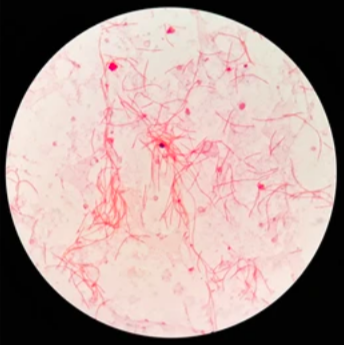A bacterial smear is a thin layer of bacteria placed on a microscope slide for staining and examination. This technique is vital because most bacteria are transparent and require staining to be visible under a microscope. Proper smear preparation ensures that bacteria retain their shape and arrangement, allowing for accurate observation.

Table of Contents
Materials Needed for Bacterial smear
- To prepare a bacterial smear, gather the following materials:
- Clean, grease-free microscope slides
- Inoculating loop or needle
- Bunsen burner or alcohol lamp
- Sterile water or saline solution
- Bacterial culture (from agar plate or broth)
- Staining reagents (e.g., crystal violet, safranin)
- Bibulous paper or absorbent paper
- Microscope
Step-by-Step Guide to Preparing a Bacterial Smear
1. Label the Slide
Using a pencil or marker, label one end of the slide with the sample’s name or identification number. This helps in keeping track of multiple samples.
2. Prepare the Slide
- Place a small drop of sterile water or saline in the center of the slide if using bacteria from a solid medium.
- If using a broth culture, this step can be skipped as the broth already contains liquid.
3. Obtain the Bacterial Sample
- Sterilize the inoculating loop by passing it through the flame until red-hot. Allow it to cool.
- Gently touch the cooled loop to a bacterial colony on the agar plate or dip it into the broth culture.
4. Apply the Bacteria to the Slide
- Mix the bacteria with the drop of water on the slide, spreading it to form a thin, even layer.
- Avoid making the smear too thick, as this can hinder observation and staining.
5. Air-Dry the Smear
Allow the smear to air-dry completely. Do not use heat to speed up drying, as this can cause cell distortion.
6. Heat-Fix the Smear
- Once dry, pass the slide quickly through the flame of a Bunsen burner 2-3 times with the smear side up.
- This process kills the bacteria and fixes them to the slide, preventing them from washing off during staining.
Importance of Proper Smear Preparation
A well-prepared smear is crucial for accurate staining and observation. An improperly prepared smear can lead to:
- Overly Thick Smears: Can prevent proper staining and obscure cellular details.
- Incomplete Drying: Can cause cells to burst during heat fixation.
- Overheating: Can distort cell shape and size.
Common Mistakes and How to Avoid Them
Using Too Much Bacteria: Only a small amount is needed. Excess bacteria can make the smear too thick.
Not Allowing the Smear to Dry Completely: Ensure the smear is fully dry before heat-fixing.
Overheating During Fixation: Pass the slide through the flame quickly to avoid overheating.
Applications of Bacterial Smear Preparation
Bacterial smears are foundational for various staining techniques, including:
Simple Staining: Uses a single dye to highlight bacterial cells.
Gram Staining: Differentiates bacteria into Gram-positive and Gram-negative based on cell wall properties.
Acid-Fast Staining: Identifies acid-fast bacteria like Mycobacterium species.
These staining techniques aid in bacterial identification, understanding morphology, and diagnosing infections.
Conclusion
Mastering the preparation of bacterial smears is essential for anyone studying microbiology. This technique lays the groundwork for accurate staining and observation, enabling researchers and clinicians to identify and understand bacterial species effectively. By following the steps outlined above and avoiding common mistakes, one can prepare high-quality smears suitable for various staining procedures.
Frequently Asked Questions (FAQ)
What is the purpose of bacterial smear preparation in microbiology studies?
The primary purpose of bacterial smear preparation is to prepare a thin layer of bacteria on a slide, fix it to the slide, and allow it to be stained for microscopic observation, according to the lowa State University. This procedure helps visualize bacteria, which are typically transparent, and determine their size, shape, and arrangement.
What is the purpose of bacterial smear preparation?
The primary purpose of bacterial smear preparation is to get bacteria ready for staining and microscopic observation. It involves spreading a thin layer of bacteria on a slide, drying it, and fixing it to the slide, ensuring the bacteria stay attached and stained well. This process allows microbiologists to study the morphology, arrangement, and staining characteristics of bacteria.
Give some precautions in preparation of bacterial smear?
To properly prepare a bacterial smear, ensuring it’s thin and representative, a few precautions should be taken. These include using a clean slide, transferring a small amount of bacteria, spreading it evenly, allowing it to air dry, and then heat-fixing it correctly.
Related Articles




